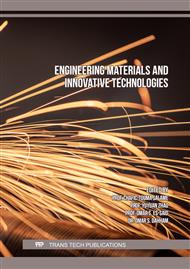[1]
Z. Sun, R. Karppi: The application of electron beam welding for the joining of dissimilar metals: an overview. J Mater Process Technol, vol. 59(3), pp.257-267 (1996).
DOI: 10.1016/0924-0136(95)02150-7
Google Scholar
[2]
M. St. Węglowski et al.: Electron beam welding - characteristics of the method. Welding Institute Bulletin, vol. 58(2014), no. 3, pp.25-32.
Google Scholar
[3]
P. Śliwiński, K. Kwieciński: Electron beam brazing of austenitic stainless steel AISI 304. Welding Institute Bulletin, vol. 65(2021), no. 3, pp.55-62.
DOI: 10.17729/ebis.2021.2/5
Google Scholar
[4]
P. Śliwiński, K. Kwieciński, M. Piotrowski.: Investigation of brazing process of titanium sheets by EBB method. Conference Proceedings: Symposium of the Welding Faculties and Departments Modern applications of welding technologies,, Poland, pp.185-196 (2021).
Google Scholar
[5]
W. Ting et al.: Feasibility study on feeding wire electron beam brazing of pure titanium using an electron gun for space welding. Vacuum, vol. 180 (2020).
DOI: 10.1016/j.vacuum.2020.109575
Google Scholar
[6]
K. Han et al.: Interface characteristics and mechanical property of titanium/steel joint by electron beam brazing with 72Ag-28Cu filler metal. J. Manuf. Process. 59, p.58–67 (2020).
DOI: 10.1016/j.jmapro.2020.09.049
Google Scholar
[7]
R. Soltani Tashi et al.: Diffusion brazing of Ti–6Al–4V and austenitic stainless steel using silver-based interlayer. Materials & Design, vol. 54, pp.161-167 (2014).
DOI: 10.1016/j.matdes.2013.07.103
Google Scholar
[8]
Laik A. et al.: Microstructure and Interfacial Reactions During Vacuum Brazing of Stainless Steel to Titanium Using Ag-28 pct Cu Alloy. Metall Mater Trans, A 46, 771–782 (2015).
DOI: 10.1007/s11661-014-2671-9
Google Scholar
[9]
Lee J. G. et al.:Microstructure and mechanical behavior of a titanium-to-stainless steel dissimilar joint brazed with Ag-Cu alloy filler and an Ag interlayer. Materials Characterization, Vol. 129, pp.98-103 (2017).
DOI: 10.1016/j.matchar.2017.04.032
Google Scholar
[10]
Lee M.K., et al.: Phase-dependent corrosion of titanium-to-stainless steel joints brazed by Ag–Cu eutectic alloy filler and Ag interlayer. J. Nucl. Mater, Vol. 439 (1–3), pp.168-173 (2013).
DOI: 10.1016/j.jnucmat.2013.04.002
Google Scholar
[11]
C. Marinho et al.: Electrochemical response of Ti joints vacuum brazed with TiCuNi, AgCu, and Ag fillers. Trans. Nonferrous Met. Soc. China,Vol. 31 (4), pp.999-1011 (2021).
DOI: 10.1016/s1003-6326(21)65556-5
Google Scholar
[12]
AWS A5.8: Specification for Filler Metals for Brazing and Braze Welding. (AWS).
Google Scholar
[13]
M. Shen, et al.: Effects of AgTi3 intermetallic on suppression of Ag agglomeration: a theoretical study. Molecular Simulation (2021).
Google Scholar
[14]
Colinet C., et al.: Structural stability of intermetallic phases in the Sn–Ti system. Calphad, vol. 33, pp.250-259 (2009).
DOI: 10.1016/j.calphad.2008.08.001
Google Scholar
[15]
Konovalihin S. et al.:. Estimation of Enthalpy of Formation of TiCu by Density Functional Method. Phys. Met. Metallogr., vol. 121, pp.1188-1192 (2020).
DOI: 10.1134/s0031918x20120078
Google Scholar
[16]
Moser Z., et al.: Calorimetric studies of the enthalpies of formation of NiTi2, NiTi and Ni3Ti. Arch. Metall. Mater, vol. 51 (2006).
Google Scholar
[17]
Taguchi O., Iijima Y.: Diffusion of copper, silver and gold in α-titanium, Philosophical Magazine A, vol. 72:6, pp.1649-1655 (1995).
DOI: 10.1080/01418619508243935
Google Scholar



